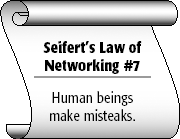5.2. The Spanning Tree Protocol
Because the problem of loop elimination in bridged catenets is universal, it was deemed appropriate to design a vendor-independent protocol to solve the problem, even if loops were created among bridges made by different manufacturers. That is, while any vendor might be able to implement a loop-elimination mechanism for use in all of its own products, there would be no guarantee that the customer's network would consist of that one vendor's products exclusively. (Although the vendor in question might surely want it to be that way!) The original standard for LAN bridges (IEEE 802.1D) [IEEE90a] included such a universal loop resolution protocol.
5.2.1. History of the Spanning Tree Protocol
LAN bridges were first conceived and developed during the mid-1980s, primarily at Digital Equipment Corp. (DEC). It was recognized even then that depending on human beings to properly configure a loop-free topology was problematic at best, and that an automatic topology configuration mechanism was needed.

As a result, DEC developed a protocol that operated among the bridges in the catenet to automatically detect and resolve loops and to configure the catenet in the best possible arrangement, where "best possible" was defined by the parameters of the protocol. Early DEC-manufactured bridges, including the popular DEC LANBridge 100, implemented this protocol. Industry ...
Get The All-New Switch Book: The Complete Guide to LAN Switching Technology, Second Edition now with the O’Reilly learning platform.
O’Reilly members experience books, live events, courses curated by job role, and more from O’Reilly and nearly 200 top publishers.

